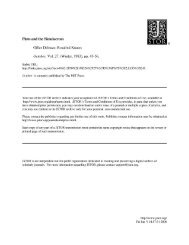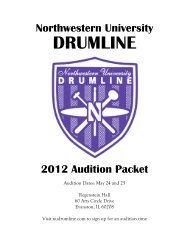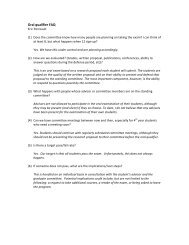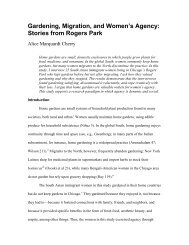research - Associated Student Government, Northwestern University
research - Associated Student Government, Northwestern University
research - Associated Student Government, Northwestern University
Create successful ePaper yourself
Turn your PDF publications into a flip-book with our unique Google optimized e-Paper software.
CULTIVATINGCOMMUNITY:Space and Capacity in Urban GardensEmily WrightDEPARTMENT OF ANTHROPOLOGYRESEARCHTimothy Keese EarleFACULTY ADVISORDEPARTMENT OF ANTHROPOLOGYHelen B. SchwartzmanSECONDARY ADVISORDEPARTMENT OF ANTHROPOLOGYJesse MummGRADUATE STUDENT MENTORDEPARTMENT OF ANTHROPOLOGYDigging in the dirt, nurturing plants, and enjoying fresh air—these are basic experiences that people share in urbangardens, during which gardeners interact and establish relationships that form the foundation on which a communitygrows. However, the spatial design of a garden, such as physical layout and leadership structure, can impose barriersto building that community. This study examines the physical and symbolic elements in five urban garden spaces andanalyzes the effects those elements have on the gardens’ community-building capacity. It concludes that collectivistgarden spaces, which provide structure for shared responsibilities, decision-making, and benefits, have greater capacityto build community than individualistic garden spaces.IntroductionUrban gardens across Chicago are envisioned asimportant spaces to build community. Characteristicstypically associated with community gardensinclude communal growing plots, group workdays,and joint decision-making. These characteristics doindeed provide ample opportunities to build the fourpillars of ‘community’, as put forth by McMillan andChavis (1986): membership—an individual’s feelingof belonging; influence—each member’s equalcontribution to the group; benefits—fulfillment ofmembers’ needs through group resources; and a sharedemotional connection through a common history,place, or experience. However, not all gardens havethose typical characteristics and as a result, urbangardens vary in their capacity to build community.In a community garden, as Kuo, et. al. (1998) argueis the case in all urban common spaces, the physicalVOLUME 7, 2011-2012features of the space influence “the quantity and qualityof informal social contact among neighbors,” in turnaffecting the development of neighborhood social tiesand the building of community (Kuo, et. al. 1998:826).Kuo, et. al. (1998) find that more lush and vegetativecommon spaces develop stronger communities in urbanneighborhoods. Whether it is the amount of vegetationor the type of seating area, the construction of gardenspace plays a key role in determining the capacity of thegarden to build community. This study examines thephysical and symbolic space of five urban gardens ina Chicago neighborhood to understand: which spatialelements enhance or diminish a garden’s communitybuildingcapacity, what progress has been made towardthe gardens’ community-building goals, and howindividual gardeners and their social positions withinthe neighborhood have shaped the garden space itself.Drawing on the theories of Lefebvre (1991) andNORTHWESTERN UNDERGRADUATE RESEARCH JOURNAL41











